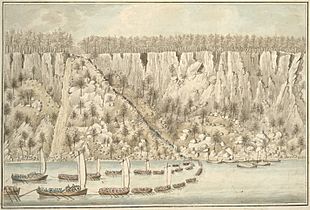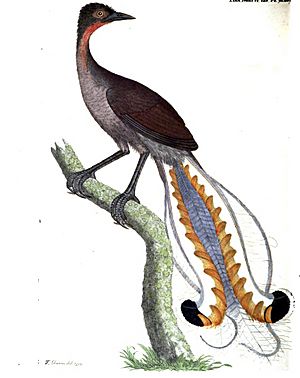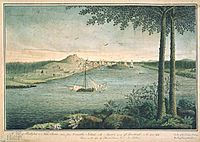Thomas Davies (British Army officer) facts for kids
Quick facts for kids
Thomas Davies
|
|
|---|---|
| Born | c. 1737 Shooter's Hill (London), England |
| Died | 16 March 1812 (aged 74–75) Blackheath (London), England |
| Allegiance | |
| Service/ |
Royal Artillery |
| Rank | Lieutenant-general |
| Battles/wars | French and Indian War |
Thomas Davies (around 1737 – 16 March 1812) was a British Army officer, a talented artist, and a naturalist. He was also a member of the Royal Society and the Linnean Society of London.
Born in Shooter's Hill, London, England, Thomas Davies grew up to become a Lieutenant-general in the Royal Artillery. He was very skilled at drawing and used watercolours to record military events during his time in North America. Later in life, he became famous for his art and his studies of nature. He was even the first person to draw and describe the amazing superb lyrebird.
His work wasn't widely known until 1953, when some of his paintings were sold. Later, in 1972, his art was featured in a big exhibition at the National Gallery of Canada.
Contents
Thomas Davies: Early Life
We don't know much about Thomas Davies's early years. In his will, he mentioned that his father was David Davies, who also lived in Shooter's Hill.
Military Adventures and Art
Davies started his military career in 1755 at the Royal Military Academy, Woolwich. There, he learned how to draw detailed maps and pictures for military use. By 1757, he became a second lieutenant in the Royal Artillery and began serving in Canada.
Fighting in the French and Indian War
His first known drawing shows Halifax during a failed mission to Louisbourg in 1757. The next year, he drew pictures of the military actions during the Siege of Louisbourg. He also recorded the sad event of the Expulsion of the Acadians, when many people were forced to leave their homes.
Starting in 1759, Davies joined General Jeffery Amherst's forces. He was at Fort Ticonderoga and then at Fort Crown Point. In 1760, he fought in the attack on Montreal. He even commanded a boat in a naval battle, which he also drew.
One of Davies's paintings from 1760, called A View of Fort La Galette, Indian Castle, and Taking a French Ship of War on the River St. Lawrence, is very important. It shows not only the fort and the river battle but also the clothes worn by local Indigenous people. In 1755, about 3,000 Haudenosaunee people lived near Fort La Galette.
After the attack on Montreal, Davies spent several years exploring the areas around Lake Ontario. He created both military maps and beautiful landscape paintings. He drew many waterfalls, including Great Seneca Falls and Niagara Falls. His 1762 watercolour of Niagara Falls, An East View of the Great Cataract of Niagara, was the first accurate drawing of the falls by someone who had seen them.
Serving in the American Revolutionary War
In 1776, Davies returned to North America with General William Howe during the American War for Independence. After the Battle of Long Island in August, he drew the British ships in the harbour. Later that year, he continued with General Howe at the Battle of White Plains and the Battle of Fort Washington, where he drew the battle scene.
Under General Charles Cornwallis at the Battle of Fort Lee, Davies drew the British soldiers landing and climbing the Palisades. This artwork was sometimes thought to be by Lord Francis Rawdon, because he later bought it from Davies.
In 1777, Davies was sent to command Fort Knyphausen, which was previously known as Fort Washington. He returned to England in 1780.
- Battle Illustrations
Leading the Royal Artillery
After the war, Davies received several promotions. He was given command positions in places like Gibraltar, the West Indies, and Canada. In 1799, he became a colonel commandant of the Royal Artillery. His final promotion was to the rank of lieutenant-general in 1803.
Artist and Naturalist: Discovering Nature
In 1781, Thomas Davies was chosen to be a member of the Royal Society, a famous group for scientists. He was also a member of the Linnean Society of London, where he wrote several articles. Many of these articles were about ornithology, which is the study of birds, especially those in Australia.
In 1800, he made a big discovery: he was the first person to draw and describe the superb lyrebird! He shared his findings in the Transactions of the Linnean Society of London. He also presented reports to the society about other animals, like the southern emu-wren from Australia and the meadow jumping mouse from Canada.
Davies's Artistic Style
Thomas Davies's art style is special because it combines the careful detail of military drawings with the beauty of nature studies. His works have been compared to those of famous artists like Henri Rousseau and Paul Sandby.
Gallery
-
A View of the Plundering and Burning of the City of Grimross, forcing the expulsion of the Acadians (1758)
-
St. John River Campaign: The Construction of Fort Frederick (1758)











